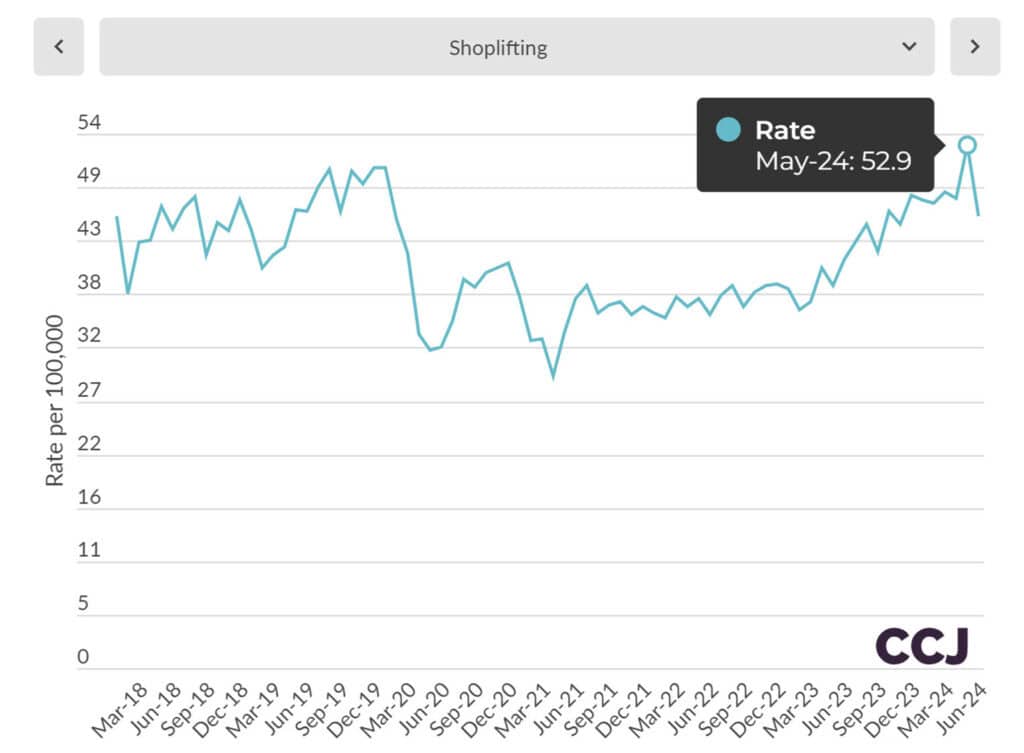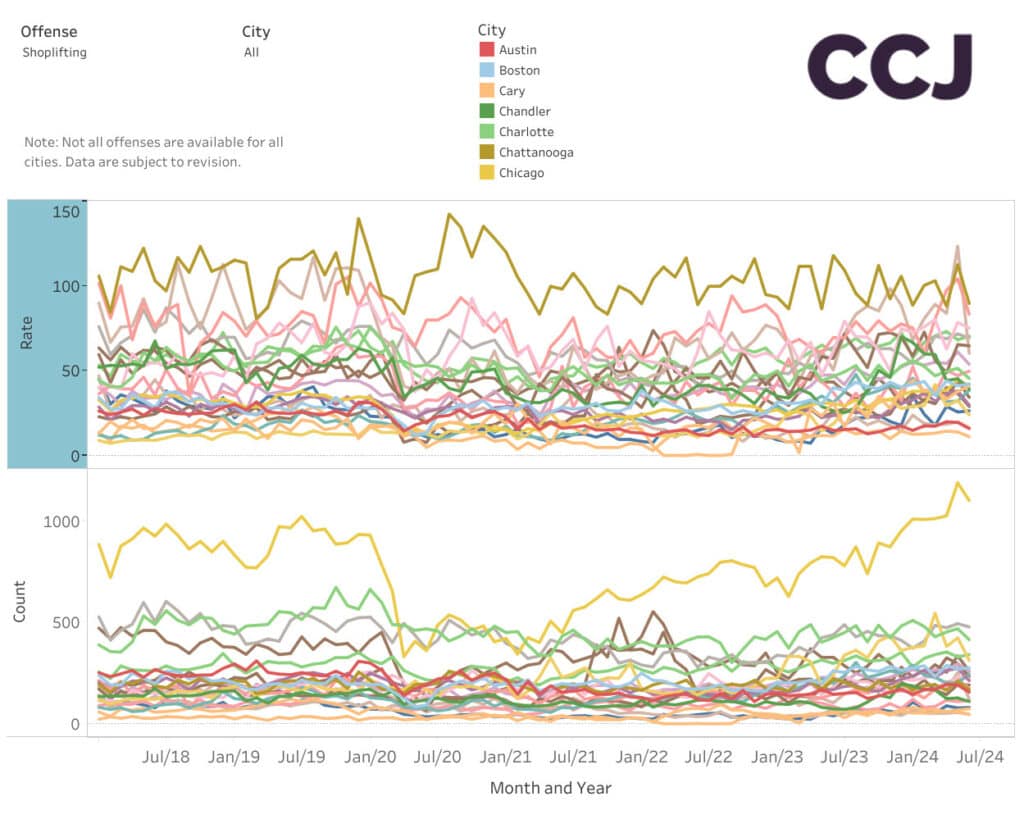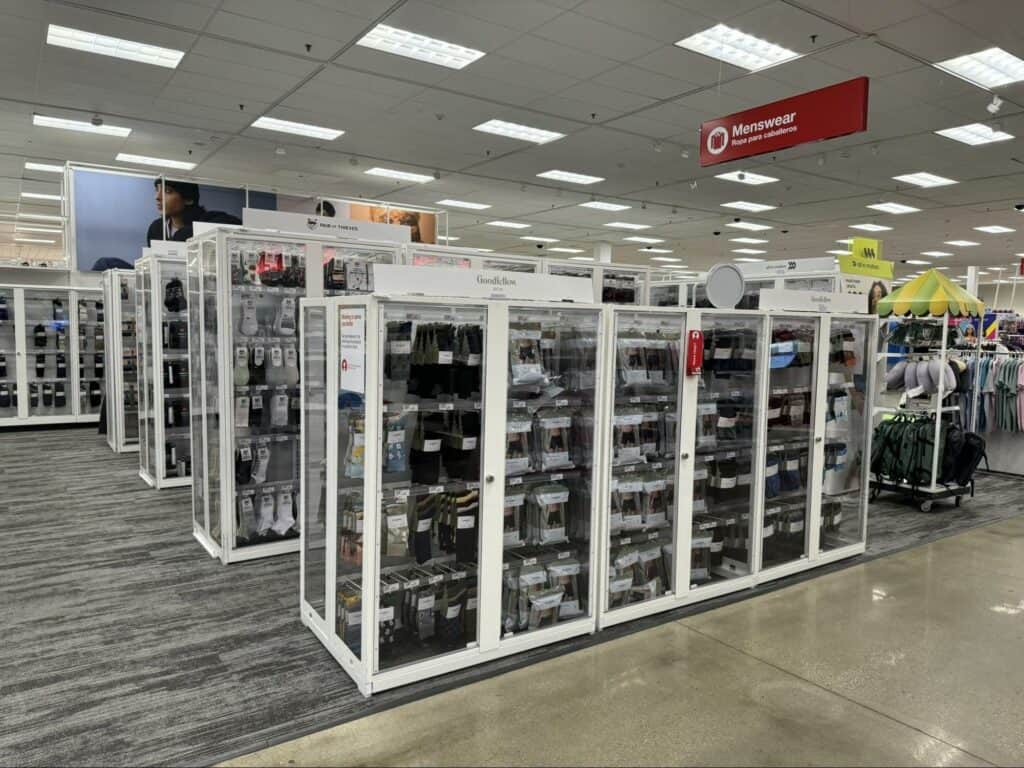
Image generated using ChatGPT
August 9, 2024
At What Point Does Loss Prevention Cross Into Sales Prevention?
Earlier this month, the Council on Criminal Justice (CCJ) released statistics on crime rates across the country, which quantified the rising concern retailers have been facing regarding shoplifting. Despite falling rates of violent crime across the country to either at or below pre-pandemic levels, one statistic stands out: Retail theft is on the rise at an alarming rate, up 24% in the first half of the year compared to the same period in 2023. In May of this year, the CCJ reported the highest monthly crime rate since before 2018 for shoplifting, as depicted in the below chart.

The rising shoplifting rates also account for a trend known as “flash mob” robberies as a form of organized retail crime (ORC), in which a group of shoplifters will raid a specific location. Data from the CCJ is available for major cities, covering a sampling of large and small jurisdictions across approximately 40 key cities that have shared data consistently over the last six years. As shown in the below chart, these issues are not exclusive to one region of the country. Little Rock, Chattanooga, Fayetteville, Durham, and Omaha had some of the highest rates reported.

What’s driving this continued rise? Some opinion pieces rationalize these acts as retaliation in response to corporate greed following a trend of increased price gouging and inflation amidst record-high corporate profits. This perspective suggests that economic pressures and perceived injustices are fueling the rise in theft. Faced with this, some companies are even resorting to extreme tactics to stop the bleeding of profitability. Retailers are currently weighing the tradeoffs between being customer-centric and combating rising rates of shoplifting across the country.
Last year, Target executed nine store closures, noting theft as the main factor. Nordstrom, Whole Foods, Nike, Walgreens, and Rite Aid have all taken similar actions. Locked cases have been installed across several major chains, including Walgreens, Target, and Walmart, to encase basic items ranging from pharmacy or personal care items to apparel and accessories such as socks and underwear.
Many of those same retailers are also walking back self-checkout initiatives that have presented opportunities for theft. Additionally, some mall properties have hired security staff at entrances to check identification and enforce adult supervision for anyone under the age of 18. This is to help curb instances of looting, theft, property damage, and more, especially among younger shoppers. For instance, a mall in Los Angeles enacted a chaperone policy last December after a huge brawl broke out when “approximately 1,000 juveniles came to loot and damage the property.”
Another strategy some luxury retailers have begun to test, in part to combat theft, is changing to appointment-only shopping models. Most recently, a Sak’s location in San Francisco swapped to appointment-only availability, citing crime as one of the factors in this decision.

While these tactics are essential for reducing losses, they often come with a tradeoff that can impact the overall customer experience at the expense of sales. These measures can create a perception of distrust among honest customers, potentially leading to a decline in sales. The inconvenience of having to contact an associate for support is also causing an impact. In Amazon’s most recent earnings call, CEO Andy Jassy noted that the company has seen sales growth specifically in the pharmacy category due to customer reactions to locked cabinets.
In the face of surmounting obstacles, what can retailers truly do? To counterbalance some of the negatives, a ramp up in customer service and staffing can help. As one example, a primary backlash against self-checkouts was the reduction in floor support. Many customers responded with frustration that they now had to do the job of the store associate. With the absence of supervision in the checkout process, an opportunity for theft is created. Adding more staff across the store will increase expenses, of course, but a higher presence of employees can, with proper training, improve customer service and therefore increase sales, as well as be a shoplifting deterrent.
Providing a positive shopping experience is crucial, especially with discretionary spending low, particularly during an election year. Striking the right balance between loss prevention and customer-centric strategies is challenging, and there is no perfect formula, but the customer should be — and should always remain — the focus for retailers.
Discussion Questions
What approach should retailers take to combat the rise in shoplifting without alienating their customers?
What factors do you believe are most contributing to the rise in shoplifting?
Are there any retailers who are handling it correctly?
Poll
BrainTrust
Allison McCabe
Director Retail Technology, enVista
Brandon Rael
Strategy & Operations Transformation Leader
Neil Saunders
Managing Director, GlobalData
Recent Discussions







From our extensive research into this area, we have found that locking up products cost US retailers $338.3 million in lost sales in the last half year. A lot of that money was diverted to online players, particularly Amazon. And once spend and custom has been transferred, it is very difficult for a retailer to ever get it back. Most customers won’t tolerate the hassle and annoyance of having basic products locked away; especially if they need to purchase multiple ‘imprisoned’ items. This problem is exacerbated enormously if it takes longer than 30 seconds for someone to come and unlock the products. The one area where there is more acceptance is in occasional purchases of big-ticket products, like electronics. Ultimately, the blunt truth is that locking things up prevents theft – but it also prevents sales.
~$300 Million seems like an unexpectedly small – indeed almost trivial – number; it’s basically one dollar per person. I would have thought several times that.
* Sorry, I originally said year and it is actually the last half year (i.e. first 6 months of this year)!
It is not larger because locking up, while annoying, is still very selective. The majority of Target stores still do not lock up products. Very few Walmart stores lock things away. And so forth. And then you have the fact that not everyone abandons a retailer entirely: some just buy from the same retailer but do so online or with curbside pickup, some still wait around for cabinets to be unlocked, etc. However, the losses grow each year as locking up becomes more common.
Thanks Neal. Yes I guess we need to put this in perspective of what percentage of goods are actually locked up; if it’s only 0.1% – or whatever – and we extrapolate that, however misleadingly, to 10-20% of all inventory, it would suddenly look like a very large number….or at least not a small one.
What I no longer tolerate is retailers charging less for online orders picked up in-store than for the same item purchased directly in the store.
Once I noticed Walgreens (in NYC) was charging 30%- 40% less for certain Bounty paper towels if purchased as a “pick up” rather than buying in the store I stopped in-store shopping.
With the pick-up option I also avoid the wait for the staff to go to the storage room to get the paper towels. (None are on the shelf) I no longer browse or make impulse purchases when I pick up items. Of course, not every product is less expensive if purchased for pick-up. If retailers want business they should not have different prices for different channels.
One might well take issue with some of the claims presented here – for example I don’t believe Saks really specified any reason(s) for their decision (tho crime was widely and logically speculated) but I agree there’s defintiely a perception of theft, and regardless of actual trends, it’s an ever present issue.
This is a retail forum, not a public policy forum, so I’m going to focus on what retailers directly control: and I’m going to cite – first and foremost – staffing: too many stores are understaffed. It facilitates theft and diminishes the customer experience…particularly if associates are now expected to add ‘lock monitor” to their duties.
Store policy. So much of this story is a red herring. Staff the bloody stores and have appropriate LP procedures in place. I wrote a long detailed post and it disappeared. Probably just as well, as it was a rant.
There is no way around proper store staffing. I’m sorry chains are having gross margin problems. It’s time to get back to legitimate demand forecasting. The singularity that was the pandemic is over.
Brad – The photo is heartbreaking.
Of course locked cases are “sales prevention.” But they are symptomatic of the low-trust society we are devolving into. Self-service retailing itself is in peril.
The semiotics of a locked case tells shoppers, “This store is not safe.” We may well calculate the dollar cost of lost sales due to locked up goods, and add the actual losses from theft. But are we taking measure of shoppers’ lost faith in this way of doing business?
My gut tells me this is costing much more in lost brand equity.
The fact that locked goods require help from an ever elusive sales associate only doubles the problem. No staff, no sales. While I resisted for many years, I have moved to Amazon entirely for the items I used to buy at my local CVS for three reasons: 1. Chances are that they don’t have it in inventory. 2. If I do find it, I have to extend my stay in the store by hunting for someone who can access the item. 3. If I can’t find it, I have no ability to “shop” the shelves looking for a potentential replacement. 3 strikes…
My son, frustrated by the dozens of locked cases protecting merchandise at Target, now uses the Target Circle app to get Target employees to pick his order, and he’ll pick it up two hours later. Retailers need more associates in the store, and NRF should be pushing for more consequences for thieves.
The trouble is, Cathy, that half of all shrink is associated with employees. The NRFs obsession with ORC might be better replaced with getting rid of the Retail Inventory Method it’s a guaranteed inventory distorter. And, again, more effective training and selection of store and field management
Half!? That’s wild.
At the NACDS Annual Meeting in Palm Beach, I met several retail chain executives who were frustrated with “flash mob” gang-theft.
The number of “flash mob” robberies continues to increase for one good reason: politicians who oppose law enforcement have decided not to punish the perpetrators.
As a result, gangs receive the message that they are free to act as they please without fear of repercussions. Thus, flash mobs are on the rise, and law enforcement is underfunded and disempowered.
It is the lack of law enforcement and punishment that frustrates and angers retail executives the most. As a result, many retail chains are closing stores in neighborhoods where crime is most prevalent.
Retail outlets cannot recover lost profits as a result of flash mobs. The criminals are highly skilled at grabbing the most expensive items in bulk and selling them on Ebay or similar websites.
For instance, in San Francisco last year, a group of around 80 people stormed into a high-end department store, overwhelming security and making off with over $100,000 in merchandise. This brazen act was captured on multiple cameras, yet only a handful of arrests were made, further highlighting the challenges faced by retailers and law enforcement alike.
Apologists like to tell us that insurance covers the losses but it’s not true anymore because it happens too often. So, again, the solution is to pack up what’s left and leave.
These closures result in significant job losses for employees who depend on these retail stores for their livelihoods. Many workers find themselves suddenly unemployed and struggling to find new positions in an already competitive job market.
Additionally, the absence of these stores deprives local communities of essential services and goods, further exacerbating the economic downturn in these areas. Db
I must disagree.. citing one example in a world full of retail isn’t a very compelling argument, just like Target closing 9 stores out of 1290 is a bit of a snooze. Too often, we focus on the anecdotal stories instead of looking at the big picture.
Great example, Paula; there are definitely chains that are closing unproductive stores and using crime as a cover for leaving certain locations and neighborhoods.
I agree. I think some of Target’s closures were not just about crime. They were about the challenges of making the economics work and shifting consumer preferences post-covid. Crime was just a convenient headline and it sounds better to investors.
Once you limit crimes to becoming a slap on the had for anything with a total value of under $950 (as San Francisco did) you open a very big door for people to come in and steal. Add to that a few public firings of store associates trying to intervene(how dare they) and you have successfully made retail stores a easy target. Retailers have two choices in this environment: pull out of the neighborhood altogether because the location can no longer be profitably run (and with the closure enable more online sales to the non-criminal component) or take a “long run” view and run the store at a loss while trying out innovative things like free coffee and donuts for police officers (which a WalMart in Atlanta recently did) in order to encourage a police presence there.
There are repercussions to either path. And if you go appointment only that only increases the divide between haves and have nots.
The NRF needs to get very active here, and pressure the communities they operate in to be more active in the prevention of crime. Calling it “shrink” instead of theft does not help either.
It’s the guns. It’s the guns. When you don’t know if the criminal has a gun, store policy is wise to get staff and customers out of the way – inventory is not worth a life. Cops won’t intervene even during school shootings because they don’t want to get killed, why should Timmy the Stock Boy put his life on the line to prevent a pack of underwear from walking out the door? The obscene distortion and willful misinterpretation of the 2nd Amendment since the Reagan Administration has led directly to this problem. No other major country has this issue. Get some real commonsense firearm regulation into place and this problem goes away as quickly as it emerged.
“Plexiglass as a Strategy” at Retail Pharmacies is a race to the bottom. This is shocking and essentially a bandaid on a much more significant retail crime challenge. As long as shoplifting and retail crime continue to be considered a misdemeanor, misguided strategies such as putting every item behind locked plexiglass are essentially a race to the bottom.
The retail pharmacy sector, in particular, was already challenged by a lack of positive customer experiences, and it’s full of tons of wrong kinds of friction. It’s already almost impossible to find any customer support in a typical CVS and Walgreens, as most associates are filling prescriptions, administrating vaccines, or there is a single cashier checking people out. Now, we will have to find someone to open the shelving units and entirely depend on a skeleton staff throughout the process. This is a disaster waiting to happen.
This is not the way and will only perpetuate the problem as these are the challenges the industry is facing:
Tread carefully here. We like headlines and high-visibility actions to show we’re doing “something.” Obviously, this strategy should only be deployed prudently and in locations where it is called for. But this is just one tactic, and tactics aren’t strategies. Better store staffing, more engagement with law enforcement and nearby stores, including competitors, more focus on legislative remedies… There’s a lot to consider here, including understanding your team members, who, by some estimates, are responsible for up to 1/2 of the losses.
It is important not to lose sight of the primary goal of Loss Prevention- ensuring the safety of customers and team members.
Customers demand convenience and locked merchandise adds a new pain point to the store experience. Who wins? Amazon.